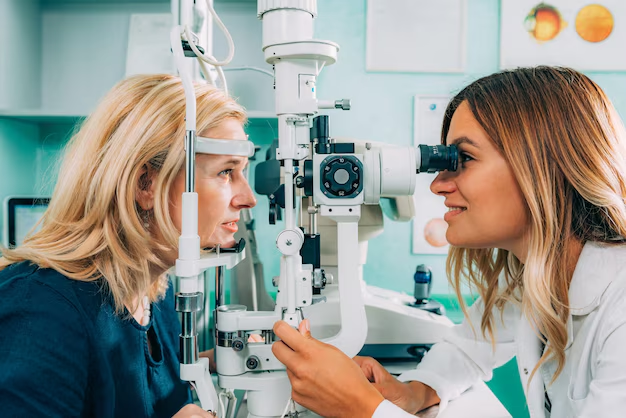Understanding Cataracts: How Do They Develop?
Imagine trying to look through a fogged-up window. Everything appears blurry and indistinct, diminishing your ability to see the world clearly. This is a simplistic metaphor for what living with cataracts can be like. While cataracts are generally associated with aging, there's much more to understand about how they develop.
🌟 What Are Cataracts?
Cataracts refer to the clouding of the eye's natural lens, which lies behind the iris and the pupil. Think of the lens as a camera lens that focuses light onto the retina at the back of the eye. A clear lens passes light through easily, allowing for a sharp image formation. However, as a cataract forms, it obstructs light from precisely hitting the retina, leading to blurred or dim vision.
🌿 The Anatomy of Cataract Development
The development of cataracts is a gradual process that typically occurs over time. Here's a breakdown of how it unfolds:
H2: The Structure of the Eye Lens
The eye lens comprises water and proteins that are arranged in a particular structure to maintain clarity and allow light passage. With age or due to other factors, these proteins may begin to clump together, creating the cloudiness associated with cataracts.
H2: Factors Influencing Cataract Development
Aging: The most prevalent factor. As individuals grow older, the lens gradually becomes less flexible, less transparent, and thicker.
Oxidative Stress: Exposure to UV rays, pollutants, and unhealthy habits can increase oxidative stress on the eyes, accelerating protein clumping.
Medical Conditions: Diseases like diabetes can hasten cataract formation due to metabolic changes in the lens.
Genetics: Family history plays a role in determining one's predisposition to developing cataracts.
Lifestyle Choices: Diet, smoking, and excessive alcohol intake can contribute to premature cataract development.
Medications: Long-term use of certain medications, such as corticosteroids, has also been linked to cataract formation.
🔍 Deep Dive into Cataract Types
Understanding the types of cataracts is essential for recognizing their impact.
H3: Nuclear Cataracts
These begin in the nucleus or central part of the lens and are typically associated with aging. Over time, the lens may harden and turn yellow or brown, affecting color perception as well as sharpness.
H3: Cortical Cataracts
Characterized by whitish, wedge-shaped opacities that start in the periphery of the lens and inch toward the center. They often cause issues with glare due to scattered light.
H3: Posterior Subcapsular Cataracts
These occur at the back of the lens. People with diabetes, high steroid usage, or those who are extremely nearsighted are more susceptible. They can advance faster than other types and are notorious for causing glare and vision problems in bright light.
H3: Congenital Cataracts
Some are born with or develop cataracts in childhood. These can be genetic or due to intrauterine infections or trauma.
📊 Visual Summary of Cataract Development Influences
Factors Contributing to Cataract Development:
| Factor | Influence |
|---|---|
| Aging | Most common; natural changes in lens proteins |
| Oxidative Stress | UV exposure, pollution, unhealthy habits |
| Medical Conditions | Particularly diabetes; can alter lens metabolism |
| Genetics | Family history elevates risk |
| Lifestyle Choices | Smoking, poor diet, excessive alcohol |
| Medications | Prolonged use of corticosteroids and others |
🔄 Cataract Progression
Cataracts typically progress through various stages before requiring intervention. Early-stage cataracts might not significantly impair vision, and regular eye exams are crucial for monitoring any advancements.
- Initial Stage: Minor clouding with negligible vision impact.
- Intermediate Stage: Noticeable symptoms like dimming or blurring; possible difficulty with glare.
- Advanced Stage: Significant vision impairment requiring surgical intervention.
🏥 When to Seek Professional Advice
While some degree of cataract presence is common as one ages, it's essential to consult an eye care specialist if:
- Vision changes rapidly or becomes severely impaired.
- Night driving becomes challenging due to glare.
- Reading and other daily activities are hindered by blurred vision.
Remember, timely consultation can aid in managing the effects of cataracts and exploring suitable solutions.
🤔 FAQs About Cataracts
H3: Are cataracts preventable?
While you cannot completely prevent cataracts, certain lifestyle changes can reduce the risk or delay onset:
- Regular Eye Exams: Detect early signs.
- Sufficient UV Protection: Wear sunglasses and hats.
- Healthy Diet: Rich in vitamins and antioxidants.
- Avoid Smoking: Reduces oxidative stress.
H3: Can cataracts cause blindness?
Untreated cataracts can lead to severe vision impairment, but they are a leading cause of treatable blindness. Surgery typically restores vision effectively.
H3: What is cataract surgery?
Cataract surgery involves replacing the clouded lens with a clear, artificial lens. It's a common and generally safe procedure that significantly improves vision.
🌟 Key Takeaways
- Lifestyle and Health: Maintaining eye health is pivotal in delaying cataract development.
- Consultation is Key: Regular check-ups can catch cataracts early, facilitating timely treatment plans.
- Education Empowers: Understanding different cataract types helps in recognizing symptoms.
Empowering yourself with knowledge about cataracts allows for informed discussions with eye care professionals and fosters proactive management of your eye health. While they are an inevitable part of aging for many, a clear understanding of cataract development and progression equips individuals to handle these changes with confidence.
